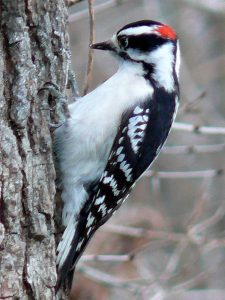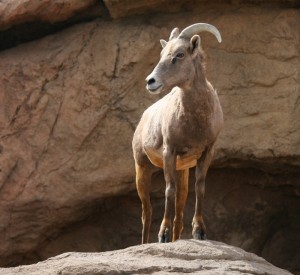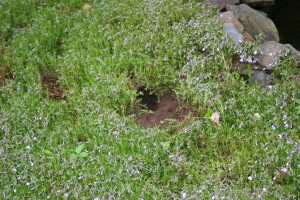General: The American mink (Neovison vison) is a medium-sized, semi-aquatic mammal that is a member of the mustelid family. The American mink is native to the United States and Canada and has been introduced to several non-native habitats as a fur-bearer and game animal. The American mink is best known for its glossy, thick, dark coat and long, lean body. Humans pose the biggest threat to this species.
Description: American mink are recognizable because of their long, slender bodies that are covered in thick, dark fur. Full-grown, males are 22.5” to 27.5” in length, while females are smaller, reaching a mature length of 18” to 22.5”. Their thick tail may make-up half their body length. Similarly, mature males tend to be about 20% heavier than females, weighing 2 to 3.5lbs. while mature females weigh 1.5 to 2.5lbs. Their length is emphasized by short sturdy legs and a long neck. American mink have flat faces and conical heads with petite eyes and ears. Because mink are semi-aquatic, their toes are webbed1.
American mink may be best known for their luxurious dark brown to black fur (made-up of a dark brown undercoat and long, oily guard hairs that waterproof the coat2.) Their thick, shiny, soft coat is accented by patches of white fur on the chin, neck and chest.
Mink don’t hibernate and are most active at dawn and dusk. A semi-aquatic mammal, mink are skilled swimmers and tend to spend much of their time in and about the water searching for food. They are capable of swimming up to 100’ underwater and diving up to 15’ below the surface. Because of their dependency on the water for hunting, mink locate their subterranean burrows along the banks of bodies of water, or take residence in the abandoned burrows of other animals. These dens are dug out then lined with dried vegetation and fur. American mink tend to use each den for only a limited time before building a new den.
Because of their aggressive and defensive nature, American mink tend to be solitary animals. Males are especially territorial and mark their home ranges with secretions from their anal glands (similar to skunks.) Mink also use chemical secretions to communicate their sexual status. Mink are known to be aggressive when faced with a threat from a predator. However, mink are skilled at avoiding confrontations because of their agility, sly nature and dark coloration that blends well with their surroundings.
In addition to chemical cues, American mink communicate using visual and auditory cues, since they have highly developed senses of hearing, vision and smell3. Mink are capable of making a limited range of sounds, including a pur when content4.
Mink may live up to 10 years old.
Habitat: American mink exist in a variety of habitats, including grasslands, forests, and marshes, but tend to prefer forested areas that offer access to water (near ponds, streams, or lakes,) and areas with brush or rock cover for protection5.
Location: American mink populations can be found across the United States and Canada (except for the southwestern United States, Hawaii, coastal areas of Canada along the Arctic and some Canadian islands.) Populations have been introduced to Newfoundland and the British Isles (where mink were accidentally released or escaped from fur farms6.)
Diet: The American mink is carnivorous and consumes a diverse diet that changes throughout the year. During warm months, their diets include aquatic animals (frogs, crayfish, and fish,) and small mammals (such as rabbits, muskrats, mice, chipmunks, and shrews.) During cold, winter months their diets consist mainly of small mammals.
American mink have been known to store extra food within their dens7.
Reproduction: American mink are promiscuous and mate annually during the winter. Fertile females may mate with multiple males. After a gestational period of 40 to 75 days, the female gives birth in the late spring to a litter of one to eight young, within a fur-lined nest. At birth, the young weigh 8 to 10g, are blind and wrinkled, and have a coat of fine white hair all over their bodies. Their eyes open around 25 days old and by six weeks they are fully weaned (although the young may remain with their mother into their first fall.) By 6 to 10 months old, the young become independent and leave their mother to establish their territories. By 10 months old, American mink reach sexual maturity8.
Notes of Interest: Humans pose the greatest threat to the American mink (because of the high value of their fur.) Mink are also hunted by coyotes, bobcats, birds of prey and other carnivores. Common to other mustelids, minks are fearless and defend themselves aggressively when faced with a threat, although their coloration and allusive nature help protect them before these threats present themselves.
Limited trapping seasons for the American mink exist in forty-seven states and in all of the Canadian provinces9.
Due to the high demand for their fur, mink are bred on fur farms. Through selective breeding, a broad spectrum of hide colors has been established, ranging from black to white. These colors have become established in some wild populations (including some in South America, Europe and Newfoundland,) because of mink that have escaped from farms or been released from farms (by animal activist groups.)
Tens of thousands of mink were intentionally released into the Soviet Union over the coarse of several decades to provide a new game animal for hunters. However, this introduction caused a severe shift in local eco-systems and had negative impacts10.
Footnotes
1. http://www.nhptv.org/natureworks/mink.htm
2. http://animaldiversity.ummz.umich.edu/accounts/Neovison_vison/
3. http://animaldiversity.ummz.umich.edu/accounts/Neovison_vison/
4. http://www.nhptv.org/natureworks/mink.htm
5. http://animaldiversity.ummz.umich.edu/accounts/Neovison_vison/
6. http://animaldiversity.ummz.umich.edu/accounts/Neovison_vison/
7. http://www.nhptv.org/natureworks/mink.htm
8. http://animaldiversity.ummz.umich.edu/accounts/Neovison_vison/
9. http://animaldiversity.ummz.umich.edu/accounts/Neovison_vison/
10. http://www.sciencedaily.com/articles/a/american_mink.htm
http://animaldiversity.ummz.umich.edu/accounts/Neovison_vison/
http://www.nhptv.org/natureworks/mink.htm
 wingspan ranges in size from 9.5” to 11.5”. The Downy has a white breast and black and white checkered wings and back, with a broad, white strip running down the center of the back. The head is striped in black and white. Males may be identified by the red patch on the nape of the neck., sometimes referred to as a cap. The outside tail feathers are predominantly white with some black markings present. The tail feathers are stiff and are used to brace the woodpecker’s body when boring holes.
wingspan ranges in size from 9.5” to 11.5”. The Downy has a white breast and black and white checkered wings and back, with a broad, white strip running down the center of the back. The head is striped in black and white. Males may be identified by the red patch on the nape of the neck., sometimes referred to as a cap. The outside tail feathers are predominantly white with some black markings present. The tail feathers are stiff and are used to brace the woodpecker’s body when boring holes. woodpecker is that this loud, rapid drumming is an attempt to bore for insects. This particular noise is actually used by the Downy to claim territory, maintain dominance or attract a mate. This particular drumming is steady and fast, approximately 17 beats a second. When excavating for food or to create a nest, the drum of the Downy tends to be slower, quieter and more deliberate in nature. The Downy also produces a short string of high notes lasting around two seconds. This shrill, descending whinny is made during mating season by both sexes6. The third noise is a high, short note made in excitement and called a pik.
woodpecker is that this loud, rapid drumming is an attempt to bore for insects. This particular noise is actually used by the Downy to claim territory, maintain dominance or attract a mate. This particular drumming is steady and fast, approximately 17 beats a second. When excavating for food or to create a nest, the drum of the Downy tends to be slower, quieter and more deliberate in nature. The Downy also produces a short string of high notes lasting around two seconds. This shrill, descending whinny is made during mating season by both sexes6. The third noise is a high, short note made in excitement and called a pik.








